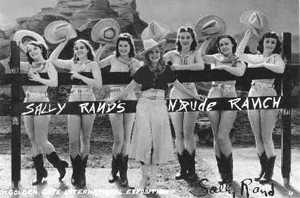Sally Rand and Yesterday's �House of Tomorrow�. (original) (raw)
News that Sally Rand would come to Texas for the Forth Worth Frontier Centennial in 1936 was met with outrage by some and curiosity by many. Her reputation, gained at the 1933 World Fair in Chicago in 1933, preceded her.
Sally Rand was a burlesque dancer who hated the term stripper when it was applied to her. In Chicago, she had been arrested four times in a single day because of a Lady Godiva act that she pulled on the streets of that city to bring attention to the Sally Rand Nude Ranch at the fair. The charges were dropped because authorities could not actually prove that she was nude, and she insisted she was not. Perhaps coincidentally and perhaps not, the Chicago World�s Fair was one of the few that actually showed a profit.

Sally Rand's Nude Ranch
Photo Courtesy Amber Di Giovanni
Though she had no way of knowing it, Rand became part of the not-always friendly rivalry between Fort Worth and its neighbor, Dallas, which was staging its own centennial, an edifying affair. Amon Carter, the Forth Worth publisher and booster, decided to go another route with his city�s celebration. �Go Elsewhere For Education, Come to Fort Worth For Entertainment� read the billboards, thousands of them, spread over several states. Aside from the slogan, the billboards showed scantily clad young women cavorting about in a Western setting. Among the people so intrigued by the billboards to change a road trip itinerary was Ernest Hemingway, who decided to go to Memphis from Idaho via Fort Worth after seeing the billboards.
The centerpiece of the Fort Worth Exposition was the revue Casa Ma�ana, (House of Tomorrow) which was directed by Broadway�s Billy Rose at a time when he was most famous for being married to Ziegfeld comedy and music star Fanny Brice.
The idea of bringing Sally Rand to Fort Worth began with Billy Rose denouncing her during an impromptu press conference announcing his involvement in Casa Ma�ana. Rose promised that his show would have �neither nudity or smut� and added, �we don�t need any fans or bubble dances at the Texas Frontier Celebration.�
Later, Carter asked Rose what he was talking about and Rose told him about Sally Rand�s fan dance and bubble dance, which she had performed at the World�s Fair. Carter asked if the show drew a lot of people and Rose assured him that it did. That�s when Amon Carter decided that Texas needed Sally Rand to help celebrate its heritage.
Born Harriet Helen Gould Beck in Missouri in 1904, the girl who grew up to be Sally Rand was one of those kids who dreams of running away to join the circus and actually did so. For a time she went under the name Billie Beck but Cecil B. DeMille, inspired by a Rand McNally atlas, had her change it to Sally Rand.
| In the book Amon: The Texan Who Played Cowboy For America, author Jerry Flemmons describes the scene at Sally Rand�s Nude Ranch this way: �Each girl wore boots and hat, a green bandana, skirtlet, tights, and the brand �SR� rubber-stamped on each fleshy thigh. The �show� consisted of girls lounging on swings and beach chairs. Some played with a beach ball. Others shot bows and arrows. One or two sat on horses.� Sally performed a �Ballet Divertissement� in Casa Ma�ana, alternating between balloons and fans for a certain amount of discretion. She always said, �The Rand is quicker than the eye� in explaining how she managed to keep audiences from seeing anything she didn�t want seen. | | | --------------------------------------------------------------------------------------------------------------------------------------------------------------------------------------------------------------------------------------------------------------------------------------------------------------------------------------------------------------------------------------------------------------------------------------------------------------------------------------------------------------------------------------------------------------------------------------------------------------------------------------------------------------------------------------------------------------------- | |
Reviews of Casa Ma�ana in the national press sometimes bordered on the ecstatic. Damon Runyon wrote, �Broadway and the Wild West are jointly producing what probably is the biggest and most original show ever seen in the United States. If you took the Polo Grounds and converted it into a caf� and then added the best Ziegfeld scenic effects, you might get something approximating Casa Ma�ana.�
Nearly all of the press coverage mentioned or featured Sally Rand. Flemmons reported that of the 17,000 stories written for newspapers around the country, half featured Sally Rand. In one 90-day period, her picture appeared in Texas newspapers 947 times.
The local publicity turned positive as Rand threw out ceremonial first pitches, spoke to service clubs and PTA meetings, bought memberships for the civic music season, traveled on behalf of Fort Worth�s centennial celebration and even gave a pep talk to the TCU football team.
The city of Fort Worth declared November 6, 1936 as �Sally Rand Day� where she was lauded for her �graciousness and consummate artistry� and officially thanked for bringing �culture and progress to the city.�
The city could afford to be nice to everybody associated with the celebration because it was wildly popular. �For what it was and where it was, Fort Worth�s Frontier Centennial, especially Casa Ma�ana, perhaps was the most successful exposition of its type in history,� Flemmons wrote.
Three years later, Runyon still seemed to be pining for the Fort Worth extravaganza. He summed up the 1939 New York World�s Fair with, �No runs, no hits, no Carters.�
No Sally Rands either.
�
Clay Coppedge May 1, 2010 Column
More "Letters from Central Texas"